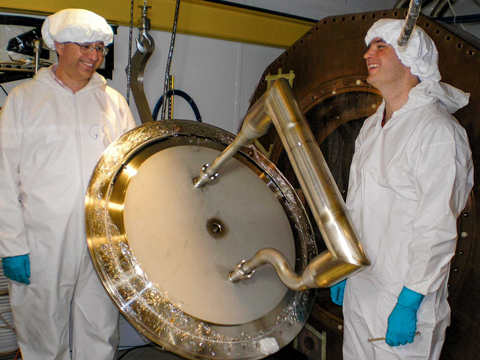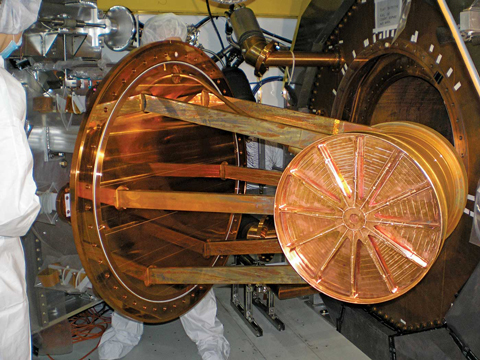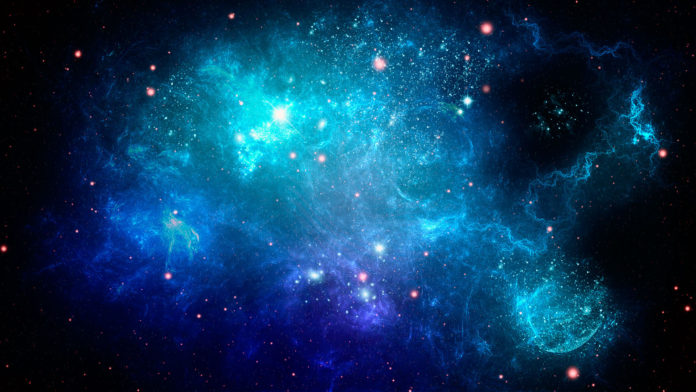Down in the New Mexico sat mines lay a subterranean tunnel that’s now being used to house the EXO-200 experiment. Once inside the facility, anyone going down the mines must first don overalls and safety equipment before being ushered onto a double-decker cage that has a capacity of just 12 people in total – six on each level. This cage is the only way into the tunnels below and takes around five minutes to reach its final destination.
Stanford physics professor, Giorgio Gratta, and his research team have recently visited the mines as part of their latest study which involves elusive subatomic particles called neutrinos. Neutrinos are much smaller than atoms and have neither a positive or negative electric charge. They may be just one of the 17 fundamental particles discovered so far, but they are by far the most abundant.
“Neutrinos are the particles that we understand the least,” says theoretical physicist and professor at Northwestern University, Andre de Gouvea. “And they are important for understanding a lot of natural phenomena.” Neutrinos come about when the nucleus of an atom goes through a change of some sort. That could be when atoms in radioactive material decompose or could also be when atomic nuclei join through fusion or split through fission.


As part of Gratta’s research, his team monitors the breakdown of a radioactive form of xenon. What they want to know is that as it decays, does it’s nuclei release other particles? They also want to see if neutrinos emerge and eradicate each other. The problem is trying to spot this interaction, if it does exist, will be very difficult. As Gratta explains, “You are dealing with very rare processes.”
The salt mines give Gratta and team an ideal place to carry out their research and hopefully one that will keep them ahead of the game in the race against other particle physicists to achieve the same goal. Discovering if neutrinos really do cancel each other out could be the missing piece of information we need to explain the great mystery of how we came to exist.
When two particles of opposite charge but equal mass meet, they can sometimes collide, and all that’s left behind is energy. When this happens, it means that one particle was the other particle’s antiparticle. These antiparticles make antimatter when put together. Because of the balance of nature, most particles of matter have an antimatter counterpart. If neutrinos have the ability to act as their own antiparticle, this could help physicists determine how there came to be more matter particles than antimatter counterparts.
Even though trillions of neutrinos are passing through you every second, there’s only a very slim chance that even just one or two of these will collide with another particle in your body. Another curious property about neutrinos is that they can come in one of thee types (or “flavors”): electron, muon, and tau. “As they travel through the atmosphere, they morph into another flavor,” says Stanford emeritus professor of physics Stan Wojcicki, who studies these transformations between the late 90’s and early 2000’s.
Although this kind of transformation is not unheard of in fundamental particles, it wasn’t expected in neutrinos. Normally these changes only happen through a quantum mechanical process. However, as confirmed by de Gouva, “The current theory of particle physics as a whole predicts that the mass of the neutrino should be zero.” If scientists could determine the precise mass, existing models could be reworked to give a more accurate theory. Hopefully, the EXO-200 experiment can help. Gratta says that if scientists do manage to spot neutrinos behaving like their own antimatter particles, they will be “automatically measuring the mass of the particles involved.”
On a wider scale, the EXO-200 experiment is essentially testing two early 20th century theories featured on the nature of neutrinos. The first was proposed by Paul Dirac, and he predicted that all particles have one of four states they can appear in, depending on their charge and how they move. However, second theory predicted by Ettore Majorana suggested that there were only two variants of each neutrino. This would mean that the same particle could cancel itself out, suggesting that neutrinos are in fact their own antiparticle. So, essentially, what Gratta and team are trying to figure out is whether or neutrinos are in fact Majorana particles. By gaining a deeper understanding of neutrinos, scientists can also gain a deeper insight into the phenomena that produced them.
The EXO-200 detector has been housed in the mines since 2007. EXO stands for Enriched Xenon Observatory, and its core consists of a 200kg (440lb) tank that’s filled with xenon. Because xenon has such a slow decay process, the detector may only detect a handful of events each year. But, to try and help boost those numbers the xenon is “enriched,” meaning any unneeded isotopes are removed while preserving the ones they predict will produce a neutrinoless decay.
The search for neutrinos has been going on since at least the 1930’s when Austrian theoretical physicist Wolfgang Pauli suggested their existence. However, after conducting several experiments, Pauli found that radioactive elements decay and release electrons with far less energy than the first predicted. Pauli suggested the reason for this may have been explained if another particle without any charge also emerged from the decay. He also believed the odds were so small that no one would ever be able to find this tiny neutral particle he bet a whole case of Champagne on it.
However, a few years later, during the 1950’s American physicists Fred Reins and Clyde Cowan rose to the challenge in their experiment called Project Poltergeist. As part of their research, the pair built a giant detector for its time that measured in at one cubic meter. However, because of the fact that the neutrino rarely comes into contact with any other particle, it took until 1956 before the duo reported they had seen a neutrino interacts with protons.
Various neutrino detectors have been built over the years, but they all tend to fit into two types. One type works by catching particles that make their way in from stars or power plants, and another type, including the EXO-200 that produce neutrinos within the detector and then proceed to measure the energy of the particles during the decay process.
Although there’s still no concrete proof that neutrinos do act as their own antiparticles, Gratta’s team has still made a few interesting discoveries. Back in 2011, they observed a rare pattern of decay where the nucleus of an atom of xenon decomposed releasing two electrons and two neutrinos as a result. This just proves it would ultimately take sextillions of years for the whole sample to be broken down in this way.
Moving forward the team will be moving on from EXO-200 to a device called NEXO that has a tank 25 times bigger than its predecessor’s. Being able to hold around five tons of liquid xenon, NEXO will allow researchers to carry out much more comprehensive research involving these particles.
Article Via; Stanford University
More News to Read
- Researchers Discover the Human Body’s Internal Clock
- Astronomers Detect Titanium Oxide for the First Time in Exoplanet WASP-19b
- Virtual Reality Travel Experiences That Will Blow Your Mind
- Astronomers Discover Fluctuations in Brightness of Unique Binary Star System
- Dark Energy Debate Takes Another Turn Thanks to New Supernova Analysis

